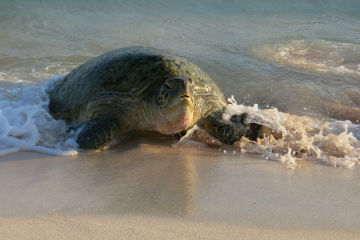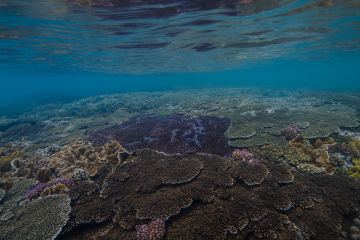Media Release ·
Thousands of turtles nesting at improved Raine Island
Raine Island Recovery Project

It’s a great boost to actually see turtles nesting on the beach areas the team worked so hard to re-profile, and it highlights that this work is making a real difference
Turtle season is in full swing at Raine Island National Park (Scientific) at Queensland’s northern tip, with more than 20,000 green turtles waiting in the sapphire waters to nest on newly profiled beaches.
Minister for Environment and the Great Barrier Reef Leeanne Enoch said the Raine Island Recovery Project team was excited to see early results from their efforts to restore and maintain the island’s vital conservation role.
“Raine Island is a globally important turtle sanctuary, which is why the Queensland Government has joined with BHP, the Great Barrier Reef Marine Park Authority, Traditional Owners and the Great Barrier Reef Foundation to invest in the future of this tiny but significant place,” Ms Enoch said.
“It’s a great boost to actually see turtles nesting on the beach areas the team worked so hard to re-profile, and it highlights that this work is making a real difference.”
Queensland Parks and Wildlife Service (QPWS) Raine Island Recovery Project Manager Tina Alderson reports that it is shaping up as a cracker of a season on the remote island.
“We’ve just finished the second trip of this nesting season as part of the five-year recovery project,” Ms Alderson said.
“More than 20,000 turtles were aggregating around the island in near-millpond conditions in early December. In drone photos, they looked like stars in a dark sky.
“During the 14-day trip to the island, rangers, researchers and Traditional Owners looked at the nesting success of the turtles in the areas where sand re-profiling works were done with heavy machinery this August.
“We’re already seeing some hatchlings this season, and the team was excited to see that the best nesting success on the island was in the re-profiled part of the beach.
“The team was up all night counting the number of nesting turtles,” Ms Alderson said.
“They also rescued 170 breeding female green turtles – either from being stuck in beach rock, trapped under small cliffs or from heat exhaustion on the beach.”
Counting and rescuing turtles were just part of the work. In addition,
- A researcher deployed wave- and current-monitoring instruments on the reef flat, to find out how sand is moved to and around the island.
- In November, satellite trackers were fitted to 20 nesting female turtles. Information about their movements will be available in January.
- Some nests have been marked by GPS, and after the baby turtles emerge, the team will be able to count how many eggs successfully hatched.
Ms Alderson said turtles weren’t the only study subjects. Researchers also did seabird surveys using drone, acoustic and visual on-ground techniques, counting more than 1750 breeding pairs of brown boobies.
A photographer was on board to record the astounding natural spectacle and the team’s efforts.
#Raine Island Recovery Project
Raine Island, on the remote northern tip of the Great Barrier Reef, is the breeding ground for one of the world’s largest populations of green turtles.
During the nesting season, as many as 60,000 female green turtles swim thousands of kilometres from their feeding grounds in Indonesia, Papua New Guinea, the Torres Strait and the West Pacific, to this tiny island to lay their eggs.
However, this amazing natural event is under threat and the island’s role as a turtle sanctuary is in danger of collapse.
The Raine Island Recovery Project is a five-year, $7.95M collaboration between the Queensland Government, BHP, the Great Barrier Reef Marine Park Authority, Wuthathi and Kemer Kemer Meriam Nation (Ugar, Mer, Erub) Traditional Owners, and the Great Barrier Reef Foundation.
#Media contact
Louise Sturgess 0409 352 493
Ben Doyle 0437 859 987





